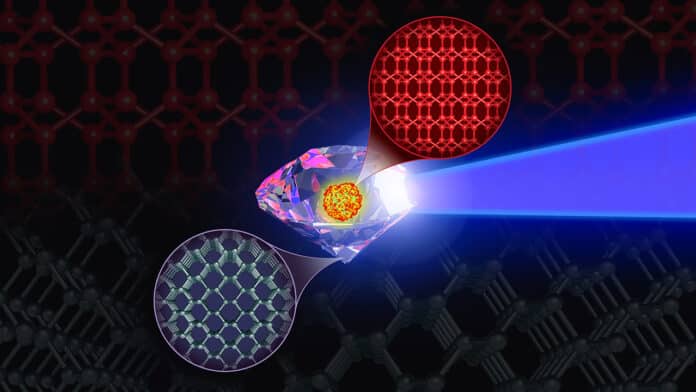Because of its extraordinarily strong carbon-carbon bond, diamonds have extraordinary physical qualities that make them extremely resilient to structural changes, even at very high pressures and temperatures. Synthesis and recovery of the theoretically expected post-diamond BC8 phase remain elusive despite multiple experimental attempts.
The body-centered cubic (BC8) crystal with eight atoms is a unique carbon phase that resembles a diamond but is not the same. It is anticipated that BC8 will be a more robust material than diamond, with a 30% higher resistance to compression. It is located in the core of exoplanets that are rich in carbon. BC8 might be categorized as a super-diamond if recovered in normal circumstances.
This crystalline high-pressure phase is expected to be the most stable phase of carbon at pressures greater than 10 million atmospheres.
Through quantum-accurate multimillion-atom molecular dynamics (MD) simulations, scientists have uncovered diamonds’ extreme metastability at very high pressures, significantly exceeding their range of thermodynamic stability.
Ivan Oleynik, a physics professor at the University of South Florida (USF) and senior author of a paper, said, “The BC8 phase of carbon at ambient conditions would be a new super-hard material that would likely be tougher than diamond.”
Lawrence Livermore National Laboratory (LLNL) scientist Marius Millot said, “Despite numerous efforts to synthesize this elusive carbon crystalline phase, including previous National Ignition Facility (NIF) campaigns, it has yet to be observed. But we believe it may exist in carbon-rich exoplanets.”
There may be carbon-rich planets outside of our solar system, according to recent space findings. Deep within these giant planets are pressures that can be millions of times greater than Earth’s atmospheric pressure.
“Consequently, the extreme conditions prevailing within these carbon-rich exoplanets may give rise to structural forms of carbon such as diamond and BC8,” Oleynik said. “Therefore, an in-depth understanding of the properties of the BC8 carbon phase becomes critical for developing accurate interior models of these exoplanets.”
A unique type of carbon known as BC8 may return to normal conditions when pressure drops while being stable under high pressure. Theoretically, in typical circumstances, BC8 carbon should similarly remain stable. According to LLNL scientist and research co-author Jon Eggert, diamonds are challenging because their structure precisely matches the atoms in the elements in column 14 of the periodic table (such as carbon, silicon, and germanium).
Eggert said, “The BC8 structure maintains this perfect tetrahedral nearest-neighbor shape but without the cleavage planes in the diamond structure. The BC8 carbon phase at ambient conditions would likely be much tougher than diamond.”
By utilizing Frontier, the world’s fastest exascale supercomputer, to run multi-million atomic molecular dynamics simulations, the team discovered that diamond exhibits extraordinary metastability at very high pressures, far outside its thermodynamic stability limit. The creation of an exact machine-learning interatomic potential, which characterizes interactions between individual atoms with previously unheard-of quantum accuracy across a broad range of high-pressure and temperature circumstances, was crucial to the achievement.
Oleynik said, “By efficiently implementing this potential on GPU-based (graphics processing unit) Frontier, we can now accurately simulate the time evolution of billions of carbon atoms under extreme conditions at experimental time and length scales. We predicted that the post-diamond BC8 phase would be experimentally accessible only within a narrow, high-pressure, high-temperature region of the carbon phase diagram.”
This is a significant discovery for two key reasons. Firstly, it explains the failure of earlier attempts to produce and detect the BC8 phase of carbon in experiments. This is because the exact pressure and temperature requirements needed to produce BC8 are challenging to meet in a laboratory. The paper also offers methods for compressing materials to achieve these particular conditions, which increases the viability of BC8 production.
Currently, Oleynik, Eggert, Millot, and associates are collaborating to investigate these theoretical avenues using specialized scientific resources on the National Ignition Facility (NIF).
In order to develop BC8 super-diamond in the lab, the scientists must first figure out how to generate the BC8 phase and then return it from its extreme state to normal conditions.
Journal Reference:
- Kien Nguyen-Cong, Jonathan T. Willman et al. Extreme Metastability of Diamond and its Transformation to the BC8 Post-Diamond Phase of Carbon. The Journal of Physical Chemistry Letters. DOI: 10.1021/acs.jpclett.3c03044
